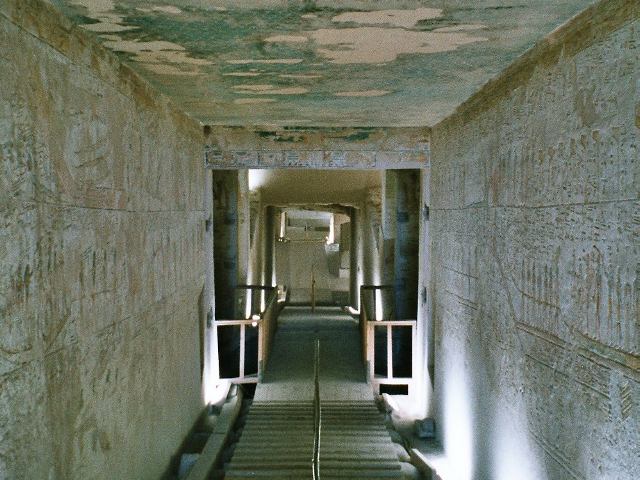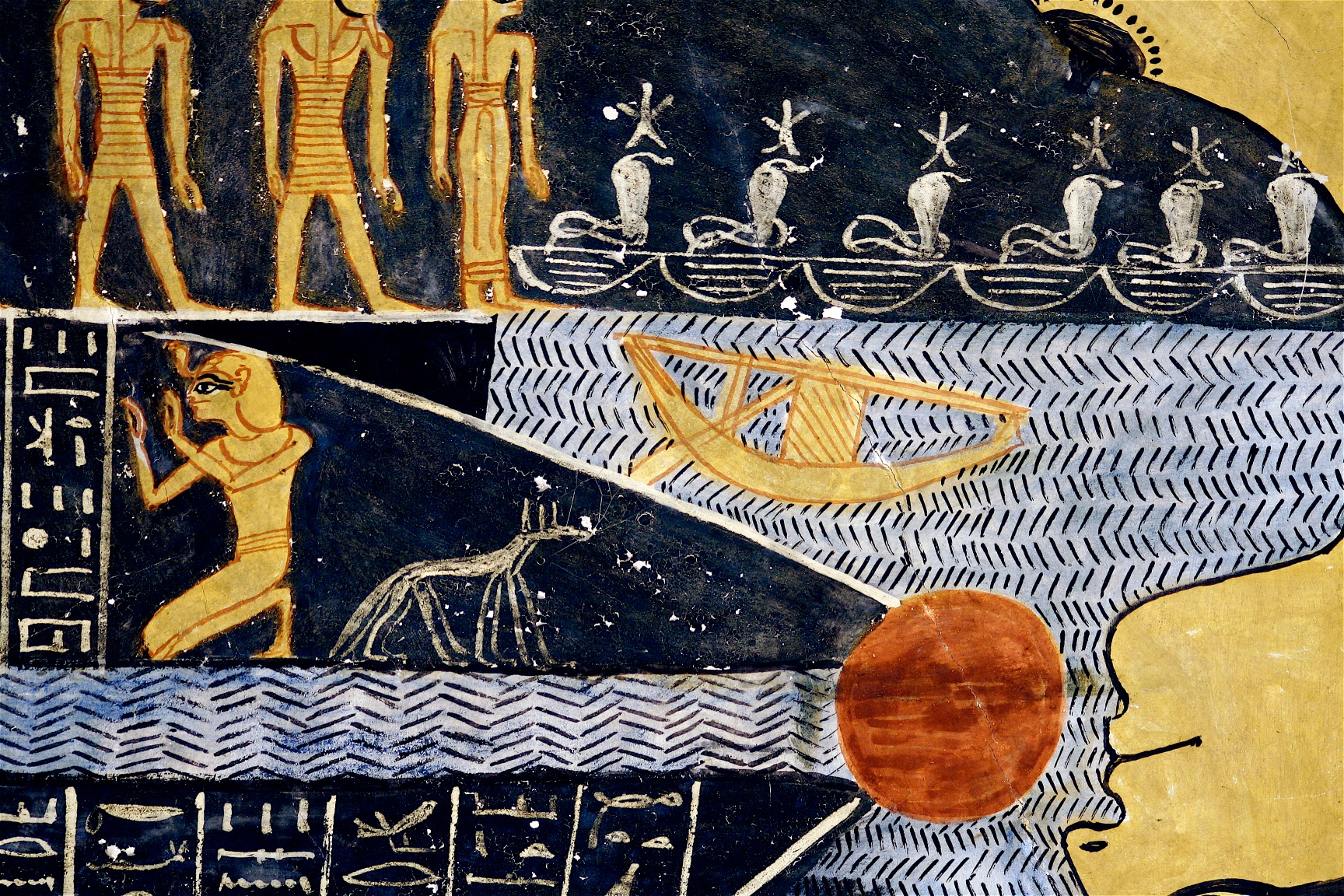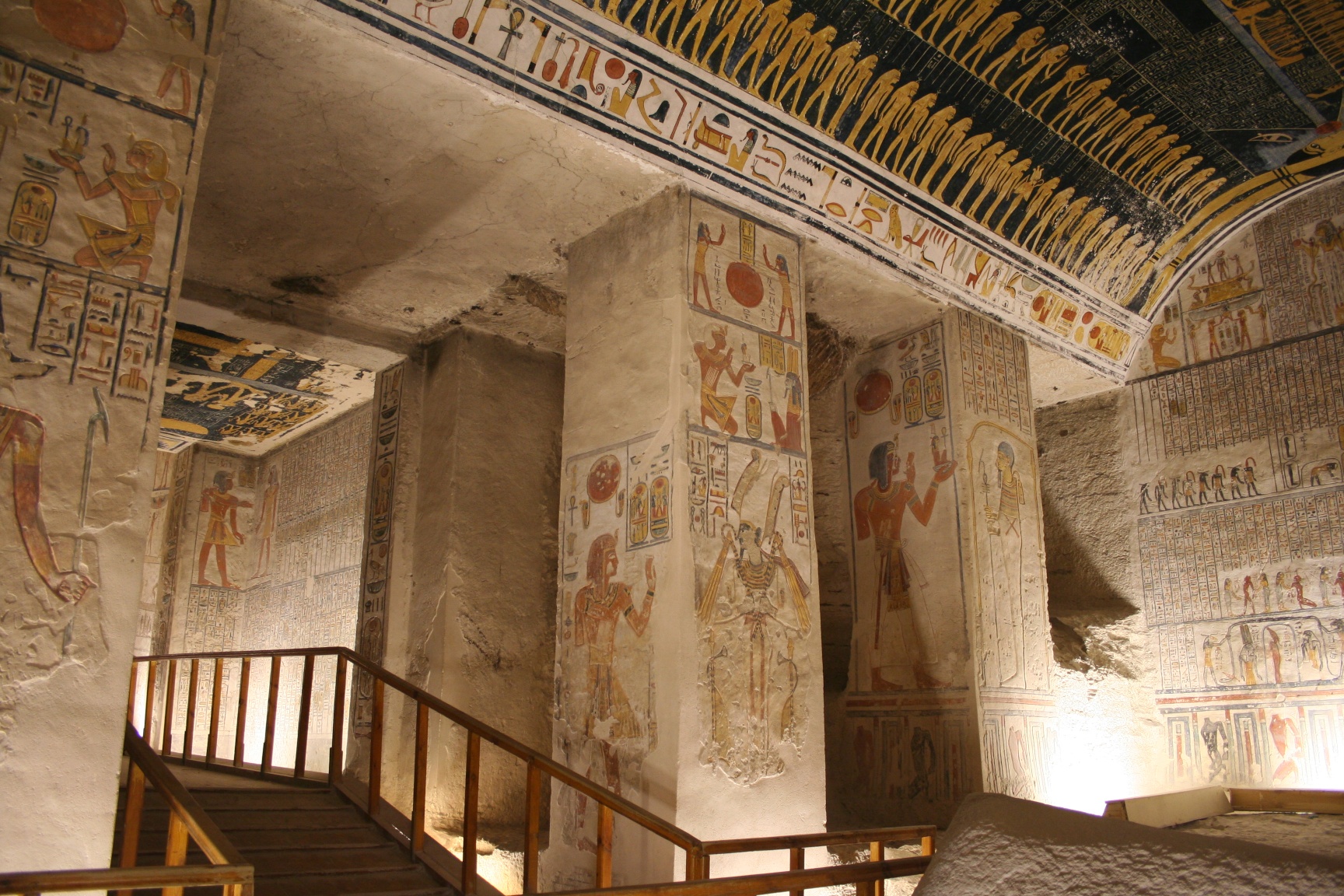We remain moored at Luxor overnight, and in the morning disembark for our trip to the legendary Valley of the Kings. The boat is scheduled to sail at 12:30 when we will depart Luxor, heading upriver to our destination in Aswan. Stops along the way will permit us to see some other temples and the trip will give us the opportunity to see more of the Egyptian countryside.
But the morning is scheduled to include visits to the Valley of the Kings , Hatshesut’s temple and Hapu temple, so we need to get an early start. We are met by Dalia and our driver with a small van just after 6 a.m. and head toward the Valley
On the way we stop for a chance to see the colossi of Memnon, a name that comes not from the Egyptians but the Greeks (which is true of many of the place names in Egypt). These 60 foot tall statues erected by Amenhotep III. The remainder of his mortuary temple is thought to have been the largest one ever built but it was plundered by later pharaohs for building materials and because it was under the water table, it has now vanished. Current excavations are focused on locating the foundations.

 Along the way we also see the on-going work at the site of Rameses II's mortuary temple, called the Rammesseum. We also pass the site of the Valley of the
Along the way we also see the on-going work at the site of Rameses II's mortuary temple, called the Rammesseum. We also pass the site of the Valley of the As we drive up through the hills, maybe a six or seven mile drive, we see Howard Carter’s house high on a hilltop near the entrance to the Valley of the Kings .
The Valley of the Kings is an amazingly forbidding place – not a speck of green anywhere. Just limestone, piles of chips from tomb construction, fragments eroded by winds and the rare rain storms. It must have taken immense courage, persistence and endurance to discover these wonderful ancient tombs.
 |
| Sunrise illuminates the hills and cliffs on the West Bank of the Nile and that's the beautiful temple of Hatshepsut, halfway up the hills, below sheer cliffs. |
 |
| Imagine this pyramid-shaped peak, capped with gold, capturing the first rays of the rising sun. |
Cameras are not allowed in the area of the tombs - the painted colors on the walls have survived 3,500 years, but light from flashbulbs can dim them. The tombs are managed to reduce the effect of tourist traffic, but not only light, but even the change in humidity from people breathing and perspiring has its effect. Dalia tells us there is a wonderful web site, the Theban Mapping Project that details the valley and each of the tombs, including detailed explanations of each of the countless scenes. (The pictures inside the valley included here come from there - we did NOT violate ban on cameras.)
The earliest burial here was Tutmoses I about 1500 BC who chose this location in hopes of defeating tomb robbers. Of course, most of the tombs were robbed in antiquity. However, for the most part the gorgeous painted walls were seen as having no value, beyond their use by bats and hiding places for occasional criminals. Because of the the very dry climate in the forbidding location and depth of the burial chambers, except for the first few dozen feet of the entry corridor, most are are in remarkably good condition.
The process of creating one of these tombs would be to select a location, cut the tomb into the mountain, smooth the walls, apply plaster, outline the panels, the red cartoons, corrections in black, then shallow carving, then painting. If a pharaoh died suddenly, you will see a completed part, parts in these various stages and some parts that may only be rough cut, because he had to be buried in seventy days after death. (The embalming process took seventy days).
The paintings are very complete and elaborate sets of spells, hundreds of feet of floor to ceiling hieroglyphs, altogether the spells the pharaoh needs to reach the next life. We are impressed by three headed winged, legged giant snake who eats you if you don’t pass the weighing of the heart before Osiris. The notion of judgment presages by a couple thousand years the idea of appearance before St. Peter. Here you stand, before the gods and your heart is weighed versus a feather. The monster or eternal life?
There are some 62 tombs that have been discovered in the valley but only a couple dozen are actually kings – the rest are royal family members, nobles and other important people. A ticket to the valley allows you to see just three tombs and there are separate tickets for some special tombs to restrict the number of visitors and thus protect the paintings. The most popular "extra” tomb in the valley is King Tut's, but Dalia tells us it is one of the smallest and least interesting. It is the only one to still contain a mummy, but except for this, virtually everything else that so amazed Howard Carter is in the Cairo Museum which we will see next week. What is most interesting is to see its location, sort of under the rubble from KV8. It is easy to see why it lay undiscovered for three millennia. To us, that was the most interesting part.
Instead we opt for a $10 ticket to the tomb of Rameses V & VI, the “chocolate” according to Dalia. Tombs may be open or closed based on weather, as well as on a rotation because just breathing can over time damage the wall paintings that have survived for so many centuries. Also for this reason guides are not allowed in the tombs. Guards will give you some information but will expect a tip.
The most crowded tombs are those closest to the valley entrance, of course. Most people are too lazy to walk any distance, and, fortunately, too cheap to pay for Rameses V/VI – their loss was our gain, and we were practically alone there.
Some of the tombs are incomplete, including that of Seti II. You can see portions with rough cut walls, some where the walls have been smoothed and some where the limestone plaster has been applied and the red cartoon of the painting completed. Some some the corrections – always in black, and some are partially painted – it appears the ochre was the first color applied. Each hieroglyph would have a specific color too.
Some of the tombs are incomplete, including that of Seti II. You can see portions with rough cut walls, some where the walls have been smoothed and some where the limestone plaster has been applied and the red cartoon of the painting completed. Some some the corrections – always in black, and some are partially painted – it appears the ochre was the first color applied. Each hieroglyph would have a specific color too.
 |
| Like many of the tombs, this one was not completed before the pharaoh died. Here are the original red drawing lines, with on a few lines of the black corrections |
The burial chamber for Seti, with the sarcophagus
This gives you a brief tour of the tomb of Seti II http://www.thebanmappingproject.com/atlas/index_kv.asp?tombID=829
The unfinished tombs can be as important as the finished ones in terms of understanding their techniques. Because the pharaoh had to be buried 70 days after his death, an unexpected death would not allow time for completion of the tomb.
KV11 was begun for Setnakht, but abandoned when the cutting of the third corridor broke into another tomb (KV 10). The tomb was later completed by is son, Rameses III, who added the side chambers and finished the tomb . After his burial was disturbed, the mummy was reburied in one of the mummy caches found in the 1800s. The tomb has been partly accessible since antiquity. The side chambers are decorated with some unusual scenes that show food preparation and tomb equipment, and there is also an beautiful pair of harpists, portrayed as many ancient musicians were, as blind. Early explorers called KV 11 "The Harper's Tomb" because of these scenes.
Below is the entrance to KV 11

Note the star pattern on the ceiling in the picture below. Nepret, Renenutet and Hu portrayed as cobras.

A portrait of Rameses III

Depicted on the walls of tombs were the offerings that the king wished to receive in the afterlife. Here we see Star pattern; bundles of wood, stone beads, Mycenaean stirrup jars, stone vessel, and amphorae.

The harpers that gave this tomb its nickname.

The tomb of Rameses IX, KV 6, is unfinished, as many are, but is very interesting, and very lovely. After the death of the king, the remaining plastering and painting of the ceiling and walls of the tomb was hastily finished. The walls of KV 6 contain over fifty graffiti, mainly located on the upper part of the walls, indicating the tomb was partly filled with debris during antiquity.
.

This is the astronomical ceiling in the burial chamber.

The sarcophagus, now missing, would have been here. The heavy sarcophagus would not likely be removed by tomb robbers but may have been taken for "re-use,"
KV 9, was begun by Rameses V but he died with it incomplete and Rameses VI took it over for his own, enlarging it and completing the decorations. He also died before the tomb could be completed to his satisfaction, but he was buried here. It contains a virtual treatise on Egyptian theology. It even contains the smashed sarcophagus. We are almost alone it it and the images, including Nut and the astronomical depictions have us leaning over backwards until our necks are stiff.
Dalia was SO right to be sure we saw this one.

Book of the Caverns, Books of the Night, Book of the Earth.... gorgeous works depicted in loving detail.

The conclusion of the Book of Day with the goddess Nut about to swallow the sun. This is a popular ceiling illustration.


This enignmatic scene contains on the right Greek visitors' graffiti 


If you go to the Valley of the Kings, don't miss this one! This is 3,100 years old and still stunningly beautiful!
We could have stayed here for hours, for our ship is to sail just after noon, and we have other marvels we want to see.
We could have stayed here for hours, for our ship is to sail just after noon, and we have other marvels we want to see.






No comments:
Post a Comment